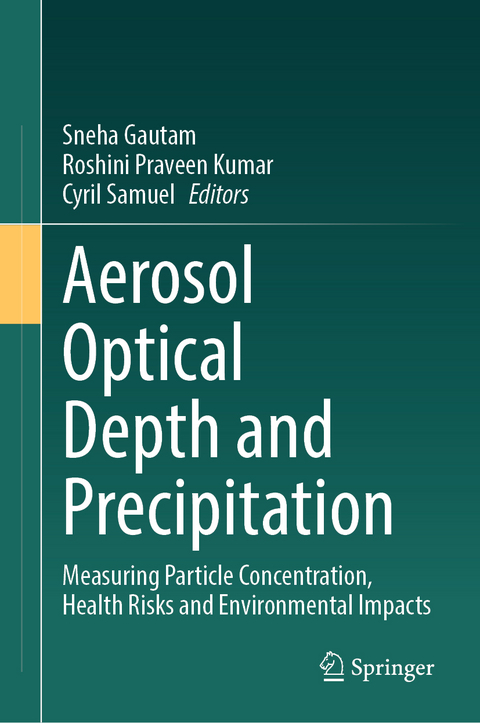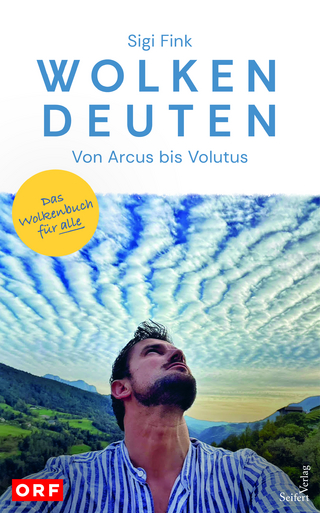
Aerosol Optical Depth and Precipitation
Springer International Publishing (Verlag)
978-3-031-55835-1 (ISBN)
Dr. Sneha Gautam is an Associate Professor at the Department of Civil Engineering at Karunya Institute of Technology and Sciences, Coimbatore, India. He holds a Ph.D. in Engineering from the Indian Institute of Technology (IIT), Kharagpur, and an M.Tech in Environmental Science and Engineering from the Indian Institute of Technology, Indian School of Mines (IIT - ISM) Dhanbad. Following his Ph.D., Dr. Gautam has had a distinguished career. He worked at INCLEN and the University of California, Berkeley, USA, from May 2015 to July 2016. Subsequently, he received a Postdoctoral Fellowship from the Ministry of Science and Technology, Taiwan, and continued his postdoctoral work from August 2016 to May 2017. Later, he served as an Assistant Professor & Head at Marwadi University, Rajkot, Gujarat, from September 2017 to April 2019. Dr. Gautam's research is at the intersection of clean air engineering/science, human health, and smart/sustainable living in urban environments. His work delves into the formation and emission of particles, with a focus on both vehicular and non-vehicular sources, particularly in the context of megacities. His contributions extend to developing low-cost sensing approaches and aiding in the formulation of exposure control technology and guidelines for policymakers, leading to improved urban air quality and associated health benefits. Additionally, Dr. Gautam has served as an editor for various journals and has published papers in diverse multidisciplinary fields. His commitment to advancing knowledge and addressing environmental challenges is evident in his extensive contributions to academia and research
Roshini Praveen Kumar, a dedicated individual, completed her B.E. in Civil Engineering at VDIT-Haliyal in 2019. Subsequently, she pursued an M. Tech. in Environment and Water Resource at Karunya Institute of Technology and Sciences, Coimbatore, India, from 2019 to 2021. With a focus on aerosol retrieval studies and the exploration of interactions between aerosols and precipitation, she has contributed to published papers in these areas. Currently serving as an Assistant Professor, she actively engages in research and education within the field of Climate and Water Resources. Her commitment is further demonstrated by her pursuit of a Ph.D. in the same domain, reflecting a dedication to advancing knowledge in these crucial areas. Her academic journey reflects her passion for addressing environmental challenges, particularly in rainfall, climate, and river basin studies, aiming to make meaningful contributions to her field.
Cyril Samuel, a distinguished professional, earned his B. Tech in Civil Engineering from Karunya Institute of Technology and Sciences Coimbatore, India in 2016. Following this, he gained practical experience at St. Andrews Infrastructure from 2016 to 2017. Since 2017, he has been actively involved in consulting and interior design projects through his own firm, Aesthetic Draftsman. Building on his industry experience, he pursued an M. Tech. in Environment and Water Resource at Karunya Institute of Technology and Sciences from 2019 to 2021.Currently serving as an Assistant Professor at the Institute, he simultaneously pursues a Ph.D. in the field of Air Pollution and Lightning. His diverse contributions include published papers in aerosol retrieval studies and exploring the interaction between aerosols and precipitation
Chapter 1 Unravelling the Complex Relationships between Aerosol Optical Depth and Temperature.- Chapter 2 Impact Assessments of Aerosol Optical Depth and Lightning on Thunderstorm over the Region of Uttarakhand, India.- Chapter 3 Aerosol Variability and its Impact on Cloud-Precipitation Interaction in Urban Areas of Maharashtra, India.- Chapter 4 Comparative Health Risk Assessment of Black Carbon and Particulate Matter Emissions in East India during the COVID-19 First and Second Waves.- Chapter 5 Source and Risk Assessment of Polychlorinated Biphenyls (PCBs) in Ambient Air and its Human Health Implications.- Chapter 6 Air Pollution in the Southern Part of Iraq and Its Health Risks.- Chapter 7 Optical Characteristics and Radiative Effects of Anthropogenic and Natural Aerosols over an Urban Area.- Chapter 8 Innovative Air-Purifying Mask.- Chapter 9 Atmospheric Particulate Matter in Bangladesh.- Chapter 10 Review of the Role of Aerosols in the Spread of COVID-19.- Chapter 11 Aerosol-Social-Health Nexus.- Chapter 12 Aerosol Optical Depth vs. PM2.5.- Chapter 13 Monsoon Shifts and Their Impact on Air Quality and Weather.- Chapter 14 Evaluation and Scientometric Analysis of Aerosols and Associated Implications.- Chapter 15 Anthropogenic Influence on Aerosol Optical Depth.- Chapter 16 The Effect of Additives on Particulate Matter Emissions from Biomass Combustion.
| Erscheinungsdatum | 27.04.2024 |
|---|---|
| Zusatzinfo | VI, 281 p. 81 illus., 74 illus. in color. |
| Verlagsort | Cham |
| Sprache | englisch |
| Maße | 155 x 235 mm |
| Themenwelt | Naturwissenschaften ► Geowissenschaften ► Meteorologie / Klimatologie |
| Schlagworte | Aerosol Optical Depth • Aerosols • atmospheric pollution • Disaster Risk Management • Flood Mapping • particle concentration • Remote Sensing |
| ISBN-10 | 3-031-55835-9 / 3031558359 |
| ISBN-13 | 978-3-031-55835-1 / 9783031558351 |
| Zustand | Neuware |
| Haben Sie eine Frage zum Produkt? |
aus dem Bereich


